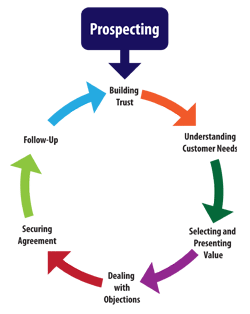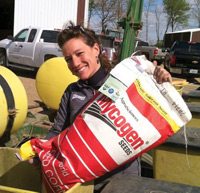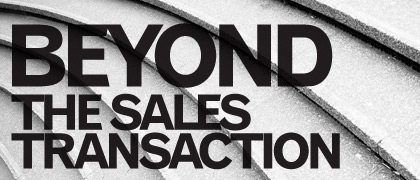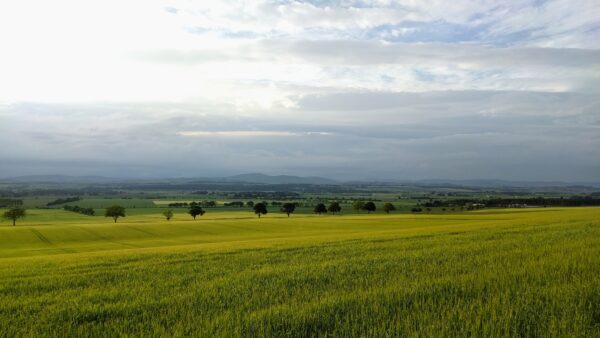A seven-step process to moving beyond the sales transaction and into a more sustainable partnership with customers.
Jenna Langley, a sales representative at Mycogen Seeds, is excited to go to work every day.
“My farmers and retailers are the people that I wake up for,” Langley says. “Each morning when I get in my pick-up, I focus on how I can add value to the customers’ operations—and I know when I see my customers, it going to be a lot of fun.”
At the same time, she knows it’s going to be hard work, too. Langley covers 15 counties in northwest Indiana and manages relationships with 50 customers. Her position is similar to many seed salespeople and one that gets increasingly more challenging as farmers become more sophisticated in their buying decisions.
Knowing how to gain a deep understanding of their customers’ operations and identifying their long-term goals will allow seed salespeople to move beyond the transaction and into a more sustainable partnership with their customers, according to Scott Downey, professor of agri-sales and marketing at Purdue University.
To achieve that partnership, Downey suggests working through a seven-step process, which starts with identifying potential customers through prospecting.
Prospecting
Often, in established seed businesses, new salespeople will start working from a list of current and previous clients, but eventually, they need to find new prospects. There are many ways salespeople can build their prospect list. By partnering with the marketing department, they can identify segments of potential customers who align well with the company’s competitive advantages. For example, they might decide to focus on farmers with 5,000 or more acres, progressive farmers or farmers with certain soil types. There may also be farmers who have attended the company’s events, like field days, but have yet to make a purchase. Those are also ideal candidates for a salesperson’s list.
Downey suggests that if a customer has seen positive performance from a company’s seed, salespeople should ask for referrals to other farmers.
“If the salesperson can clearly articulate what makes his company unique, then when he asks for referrals, he’s not just saying, ‘Who else should I peddle my products to?’” Downey explains.

There are many ways salespeople can build their prospect list. By partnering with the marketing department, they can identify segments of potential customers. |
Building Trust
It’s important for salespeople to build trust when initiating relationships with prospective buyers. Trust is established through salespeople’s words and actions, such as being honest and doing everything they can to deliver on any promises they make during a sales visit. Even actions like showing up on time are vital when building trust.
“If I show up late or without an appointment, it says to the customer that I care more about my schedule than I do about his,” Downey says.
Being a salesperson doesn’t necessarily mean having all the answers. Sometimes, it means solving problems together with the customer. By working with the customer as a partner, the salesperson can build trust to a greater degree and address some of the challenges the customer encounters.
Langley knows that she won’t always have the answer, but she is willing to find the right resource, such as one of the company’s agronomists, to help find a solution for her customers.
“I try to treat each farm like it was my own,” Langley says. “I want to make sure that I’m not over-promising or under-delivering and that my customers profit in the most positive way that they can.”
Understanding Customer Needs
With a level of trust established, salespeople can begin to ask questions that provide more specific information about the customer’s operation—not just what they want to buy. For example, a salesperson should know how the farm operates on a daily basis, what the farmer believes he needs in order to operate successfully, what resource constraints he’s facing, how the farmer wants to grow his operation, the long-term goals for the farm, etc. This is the information that’s driving the farmer’s purchasing decisions.
Selecting and Presenting Value
Armed with knowledge about the customer’s goals and needs, the salesperson can initiate a conversation about how her company’s products will help the customer achieve some of his goals or meet a vital need.
“It’s all about relating the value a product offers in a way that is meaningful to the customer,” Downey explains. “Rather than saying, ‘This seed will accomplish this because it has this trait,’ the salesperson should relate the value to the customer in a way that connects back to the things she learned when developing her understanding of the customer.”
Dealing with Objections
While working with their customers, salespeople should try to remember that in today’s marketplace, buying seed is a huge decision for farmers. Seed choice dictates the types of chemicals that will be used, and how they’re applied, as well as the equipment that a farmer will own and what their crop rotation will be. Financing and discounting, along with weather and soil variability, impact their decision, too.
Farmers are going to explore competing offers when making such a significant decision, and sometimes, the easiest way to boil it down is to say, “How much does it cost?” Price may not be the primary objection that a customer has, but it’s almost always important.
The salesperson should explain, in dollars and cents, why his seed is the right choice for the farm. The salesperson should refer back to his understanding of the customer’s operation and explain the value of his seed in terms of the customer’s main objective—profit and yield or cost.
“Objections must be approached realistically and with concern,” Downey advises. “My customer knows that I benefit from a sale, so I don’t want to hide that. But I also have to make sure that the decisions I’m recommending will benefit my customer in the ways that are important to him. If I don’t do that effectively, then it undermines trust.”
Securing Agreement
Closing the sale is about securing the farmer’s agreement and managing his expectations at the same time. It is more than getting the customer to say “yes” or sign a contract. This is the time to discuss when the customer will hear from the salesperson again and when the customer will receive the seed.
Sometimes, a customer may also need to be reminded about the decision that they have made.
“Because of the complexity in today’s market, it’s easy for the customer to remember features of a product the salesperson talked about, but the farmer chose not to buy,” Downey says. “Sometimes, a salesperson needs to ‘unsell,’ or remind the farmer about their conversations and reset the farmer’s expectations.”

“Building relationships with my customers is my favorite part of the job. Helping them reach the highest potential on their acres is the reason that I’m happy to go to work.”·— Jenna Langley |
Follow-Up
When the paperwork is finished and the expectations are
set, it’s time to deliver and follow up. The biggest way to betray trust in a relationship is to not deliver on promises.
“The salesperson should help the grower analyze performance as part of follow-up and assessment for next year—that means coming out to look at the field,” Downey suggests. “It’s a good idea to take pictures of emerging seedlings and during tasseling.”
It’s also critical to revisit the goals the farmer said he wanted to accomplish, and how the salesperson’s value proposition will help him do that. The salesperson should ensure that he has delivered the expectations he initially discussed with the farmer and that those expectations have not changed drastically.
“If a salesperson’s only follow-up comes the next time the customer is ready to make a buying decision, then the salesperson really isn’t a partner in the business,” says Downey. “In that case, you don’t have a partnership. You have an annual transaction.”
Following-up positions the salesperson to sell to the farmer for the next year. That’s when the sales process becomes cyclical, and the salesperson can initiate another conversation about the farmer’s goals. Downey suggests looking at the weather and pest threats that may have affected the original seed-buying decision and bringing them back into the conversation about the selection process the following year in order to ensure an ongoing relationship.
Langley calls on her farmers multiple times throughout the year to strengthen and maintain her partnerships.
“Although each customer writes a check for seed just once a year, I spend time with them throughout the year building partnerships and trust, which is vital to our success,” Langley says. “Building relationships with my customers is my favorite part of the job. Helping them reach the highest potential on their acres is the reason that I’m happy to go to work.”
Megan Sheridan and Kristyn Childres
Editor’s note: Megan Sheridan is the marketing director and Kristyn Childres is the marketing assistant at the Center for Food and Agricultural Business at Purdue University.











